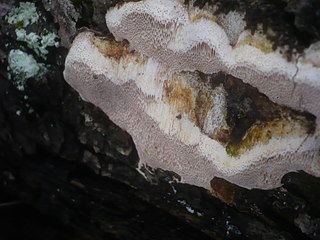
Perenniporia is a cosmopolitan genus of bracket-forming or crust-like polypores in the family Polyporaceae. They are dimitic or trimitic with smooth, thick-walled basidiospores and cause a white rot in affected wood.
Amoebophyra is a genus of dinoflagellates. Amoebophyrais a syndian parasite that infects free-living dinoflagellates that are attributed to a single species by using several host-specific parasites. It acts as "biological control agents for red tides and in defining species of Amoebophrya." Researchers have found a correlation between a large amount of host specify and the impact host parasites may have on other organisms. Due to the host specificity found in each strain of Amoebophrya's physical makeup, further studies need to be tested to determine if the Amoebophrya can act as a control against harmful algal blooms.
Alishewanella is a genus in the phylum Proteobacteria (bacteria).
Cyclorhagida is an order of kinorhynchs, which are small marine invertebrates.

Rho Delta Chi (ΡΔΧ), is an Asian-interest, but not Asian exclusive, sorority founded at the University of California, Riverside on January 17, 1991. Rho Delta Chi focuses on 4 main pillars which include: Sisterhood, Service, Scholastics, and Social. It is a rapidly expanding multicultural sorority that has expanded to over 6 chapters in the U.S.

The genus Alishewanella is one of the major branches of the family Alteromonadaceae. It was proposed to accommodate A. fetalis, isolated from an autopsy of a human fetus, in 2000. In 2009, A. aestuarii was isolated from tidal flat sediment and indicated as being a representative of Alishewanella. The third Alishewanella species was isolated from gajami sikhae, a Korean fermented food, in 2009 and was given the name A. jeotgali. Most recently, in 2010, the fourth currently isolated species of Alishewanella, A. agri, was isolated from landfill soil in Korea. Currently these are the only four isolated and characterized species of the genus Alishewanella.
Antygomonas is a genus of cyclorhagids. It is the only genus in the family Antygomonidae Adrianov & Malakhov, 1994. Species of Antygomonas are commonly referred to as "mud dragons."
Rugiloricus is a genus of marine organisms of the phylum Loricifera and the family Pliciloricidae, described by Higgins & Kristensen in 1986.
Echinoderes obtuspinosus is a species of mud dragons first found in coastal and subtidal locations around the Korean Peninsula and in the East China Sea.
Echinoderes microaperturus is a species of mud dragons first found in coastal and subtidal locations around the Korean Peninsula and in the East China Sea.
Echinoderes cernunnos is a species of mud dragons first found in coastal and subtidal locations around the Korean Peninsula and in the East China Sea.
Echinoderes aspinosus is a species of mud dragons first found in coastal and subtidal locations around the Korean Peninsula and in the East China Sea.
Roseomonas is a genus of Gram negative bacteria. The cells are coccoid rods when viewed microscopically. Certain species are known to be opportunistic infections for humans.
Echinoderidae is a family of kinorhynchs in the order Cyclorhagida.
Cephalorhyncha is a genus of kinorhynchs in the family Echinoderidae.
Polacanthoderes is a genus of kinorhynchs in the family Echinoderidae. It consists of one species, Polacanthoderes martinezi Sørensen, 2008.
Ismaridae is a family of insects belonging to the order Hymenoptera. About 50 species are known in this small relictual group; all the species for which the biology is known appear to be hyperparasitoids that parasitize Dryinidae.
Echinoderes is a genus of mud dragons first described in 1863. It is the largest genus within class Kinorhyncha. It is a highly diverse genus, with member species that inhabit "most marine benthic substrates, on latitudes ranging from the Arctic to the tropics, and from the intertidal zone down to the deep sea." Species on the east coasts of North and South America have been extensively studied by Robert P. Higgins. Species in east Asia have been extensively studied by A. V. Adrianov.
Mariniflexile is a genus in the phylum Bacteroidetes (Bacteria). The various species have been recovered from sea water, sea urchins, springs, brackish water, and an oyster.



